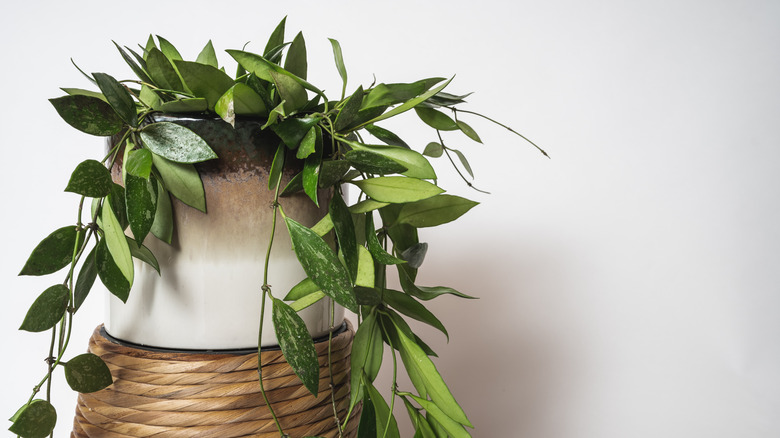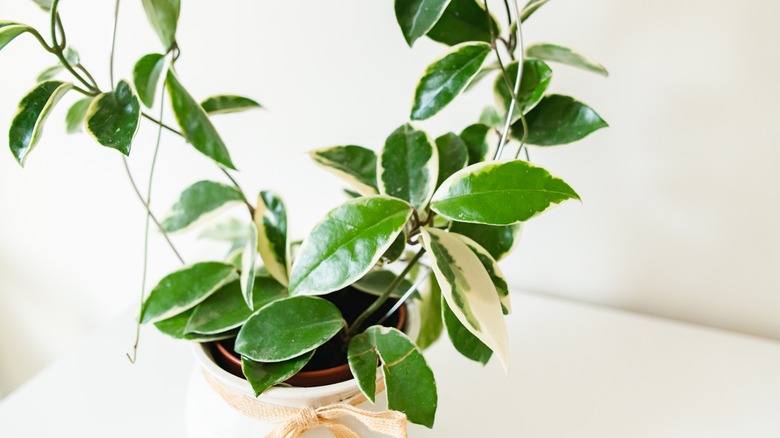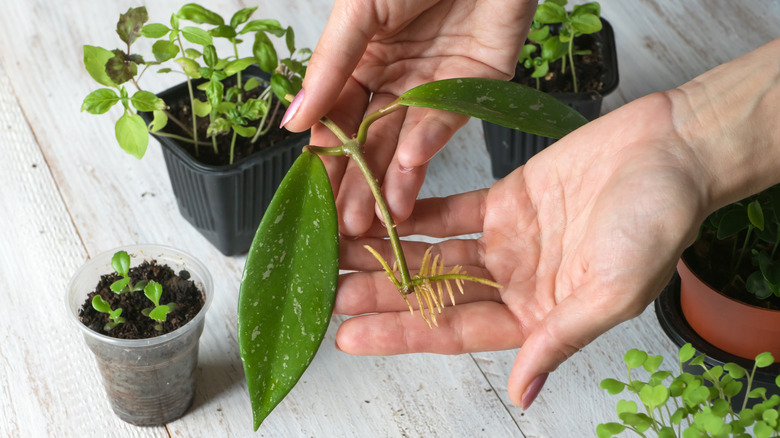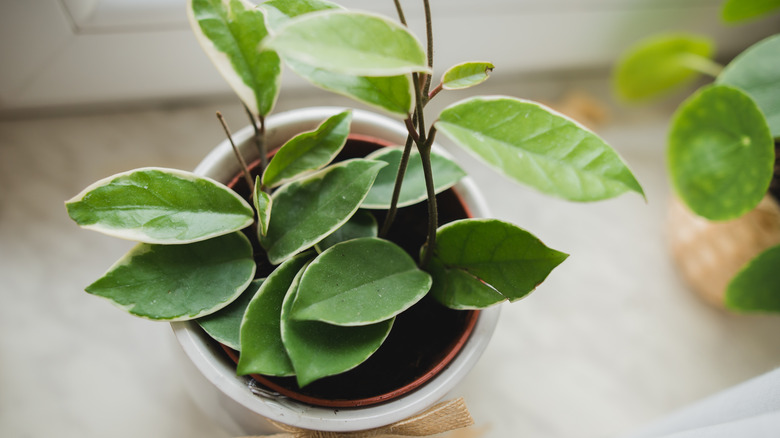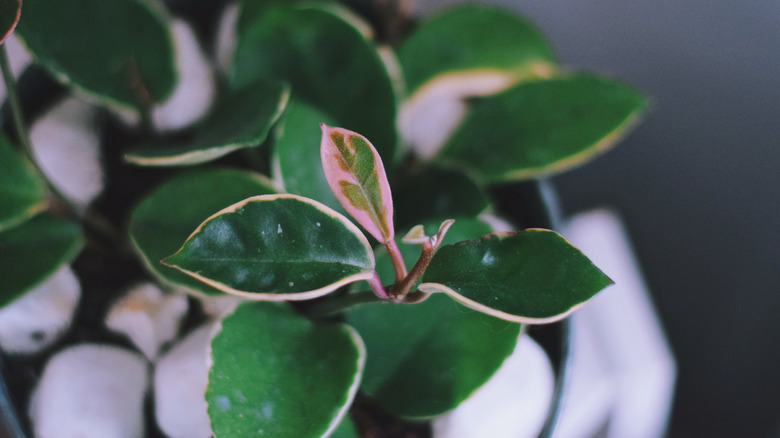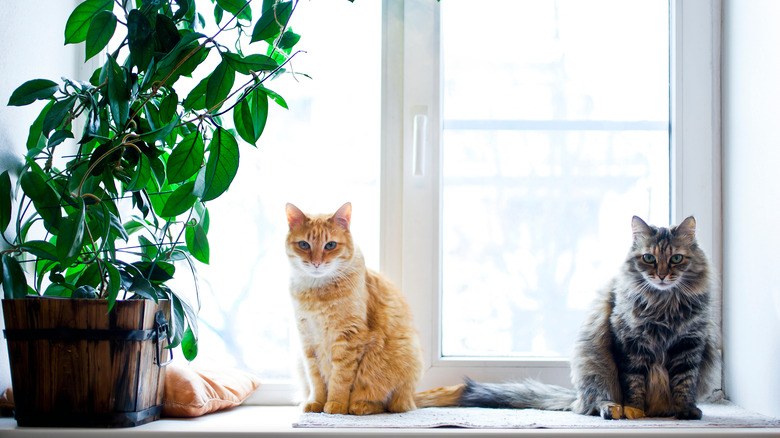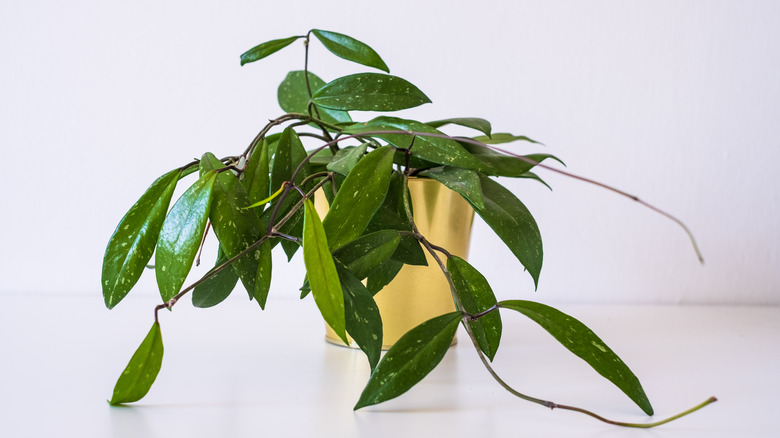How To Grow And Care For Hoya Climbing Vines
Hoya carnosa, also known as hoya climbing vines and wax plants, is an excellent plant for beginners. Its green leathery leaves and star-shaped blooms, named Porcelain Flowers, are loved because of their delicate-looking white and pink coloring. Similar to milkweed, hoya flowers smell sweet like honeysuckle. They bloom in parachute clusters that last a couple of weeks.
According to Guide To Houseplants, hoyas have vines that either trail or climb counterclockwise around trellises and can grow up to 10 feet long. Hoyas are native to Australia and tropical Asia, where they grow attached to the trees. Although their natural habitat is outdoor, people mainly use them as indoor plants as they don't need a lot of upkeep to thrive. They are also fast-growers outdoors but slow- to moderate-growers indoors, blooming best when pot-bound. As long as you follow a few simple steps, your hoya carnosa will be pushing out new growth and climbing up anything it can wrap its vines around.
How to use hoya climbing vines in the garden
Depending on the climate, hoyas can be planted outdoors. They are native to tropical areas, so hoyas won't live long if the temperature is going below freezing or the air is dry. SFGate suggests you place hoyas outside only when the temperature is consistently above 70°F during the day and is at or above 60°F during nighttime.
Since hoyas aren't usually outdoor plants in many climates, it's essential to slowly accustom them to the outdoors by only putting them outside a couple of hours a day. According to Joy Us Garden, the best place for your hoya is in a wind-protected area that provides them with bright light and shelter from the hot sun. If your air is on the dry side, spraying your hoya's foliage will help create humidity. When styling your wax plant, always remember they love to climb. Adding a trellis for the vines to clamber up will look beautiful in any garden. If you prefer having them inside, keep them in their pots, and place them on a table. The visual effect of their foliage against any home décor is on the next level.
How to grow hoya climbing vines
Growing hoya climbing vines is just as easy as caring for one. The most crucial step is patience because these plants are slow growers indoors who won't put out new growth until their root system is developed. According to Gardening Know How it takes around two years for a hoya plant to mature and be able to bloom flowers.
You can propagate a hoya plant in water or potting mix. To get a cutting, you will need to locate the nodes, which is the place where the leaves grow from the stem and where the new roots will grow from. Cuts should be done between these nodes and include at least a pair of leaves or nodes. After taking a cutting from your main hoya plant, you can place them in water or potting mix. If you choose to use potting mix, make sure to keep the plant moist; adding sphagnum peat moss to the mix will help retain moisture. By four weeks, you will start to see root growth.
How to care for hoya climbing vines
Caring for a hoya is easy and perfect for a beginner plant owner: First and foremost, they need lots of indirect light and 50% relative humidity. Guide To Houseplants advises keeping your hoya away from heaters and AC units whose air will dry out your plant's foliage. Hoyas should be fertilized monthly during the growing season.
Once you've ensured your wax plant is in the right environment, all you have to worry about is watering it about every week during the spring and summer or every two weeks in the fall and winter. Of course, you want to water your hoya more during the growing season to keep the soil moist. To ensure your plant has enough water, you can also mist it, place a humidifier nearby, or keep it in a humid place like the bathroom. However, in the winter, make sure the soil is drying out between waterings to prevent overwatering.
Hoya climbing vines varieties
There are over 2,000 varieties in the hoya genus. These plants are a part of the Apocynaceae family, and even though all the hoya varieties are a part of the same group, they can look very different. There are numerous hybridized varieties of this plant, and they even have very different care guides. Here are some of the most common hoya climbing vine plants, courtesy of Smart Garden Guide.
- The Hoya Pubicalyx is the second most common variety of hoya. Its leaves are a darker green and have an oval shape, while its flowers grow in clusters of up to 30 tiny blooms.
- The Hoya Kerrii has the prettiest heart-shaped leaves. They are often sold as a single leaf, despite this only being a cutting from a vine of heart-shaped leaves. This variety is close to a succulent because it prefers more direct light and fast-draining soil.
- The Hoya Australis is also commonly known as the Waxflower. It has red-colored stems that can grow up to 30 feet long, and when it blooms, the flowers give off a spicy fragrance.
- The Hoya Retusa maintains its popularity by being on the odder part of the hoya varieties. It has slim and flat leaves and white and maroon flowers that hardly bloom.
Are hoya climbing vines toxic?
While many plants in the Apocynaceae family are poisonous, hoya climbing vines are not toxic, meaning that it is safe to have them in the same home as young children and pets, Plant Care Today notes. However, even though ingesting a hoya plant won't be detrimental to one's health, it can still be harmful. While these plants are not poisonous or harmful to touch, some people and animals may have a reaction to consuming them. This can especially be a problem if a large amount is ingested. Again, the reaction won't be deadly but can cause vomiting.
The best way to prevent this is to keep your hoya in a hanging basket if you know your young children and pets might take off a piece of it and eat it. By planting it in a hanging basket, you are keeping it out of their reach to prevent any potential reactions. California Poison Control also notes that the hoya is not dangerous and is deemed safe around adults, children, dogs, farm animals, and other animals.
How to repot hoya climbing vines
Repotting a hoya doesn't have to be done often. Hoyas actually prefer growing in a cramped pot and will produce their best blooms under these conditions. Guide To Houseplants suggests repotting hoyas every two to three years and only in early spring. When it's time for you to transplant your wax plant, you should make sure it's not in bloom because if it is, those flowers will drop.
Choosing a new pot for your plant is a significant step: The new container should only be about 2 inches larger than the original pot. The next step in repotting a hoya climbing vine is finding the perfect potting mix. Since hoyas prefer a humid environment, the best mix would be 2/4 of a sphagnum peat moss-based potting mix and 1/4 perlite. After putting your hoya into its new home, you can add more moisture without risking root rot by placing water and small rocks onto the saucer below the pot.
